Reportedly dubbed “Whispering Death” by Japanese ground forces due to its quiet engines (courtesy of engine sleeve valves), fast and powerful Bristol Beaufighter heavy fighters were flown by Allied pilots to strike Axis shipping and ground targets in the European, North African, Mediterranean and South West Pacific theatres of World War Two. I can picture Beaufighter pilots attacking in waves, one wave knocking out flak guns, with others following, firing rockets and torpedoes along the way without mercy! By the way, that nickname was most likely given by an Australian wartime journalist rather than the enemy but has pretty much stuck ever since!
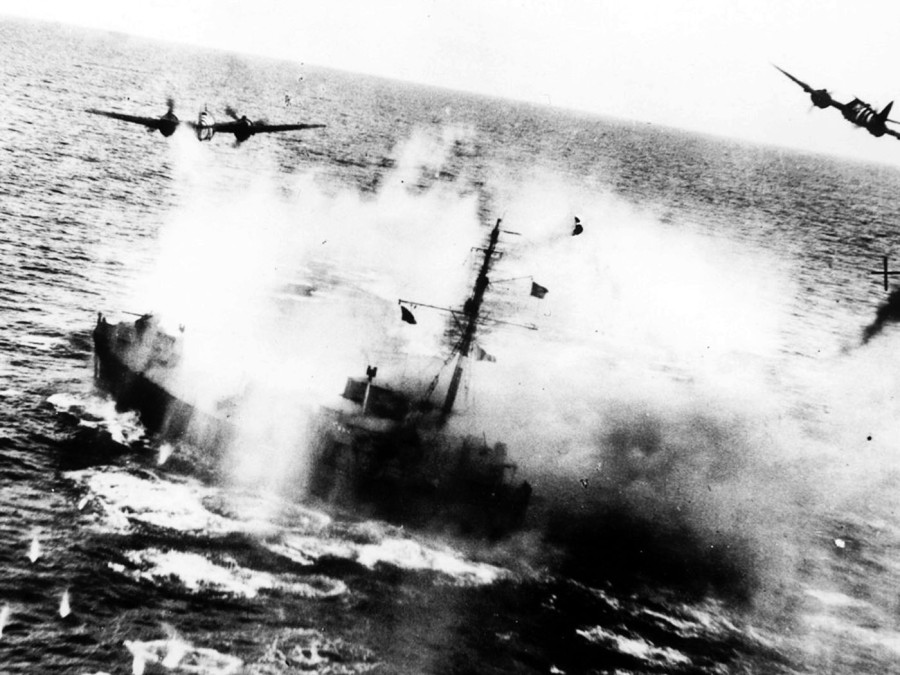
The Bristol Type 156 Beaufighter was a development of the Bristol Beaufort torpedo bomber, utilising common components such as the wings, undercarriage and tail – commonality was a huge bonus for simplified production to a nation effectively under siege by the Germans! The first Beaufighter prototype flew on July 17th, 1939 and first entered Royal Air Force service on July 27th, 1940.
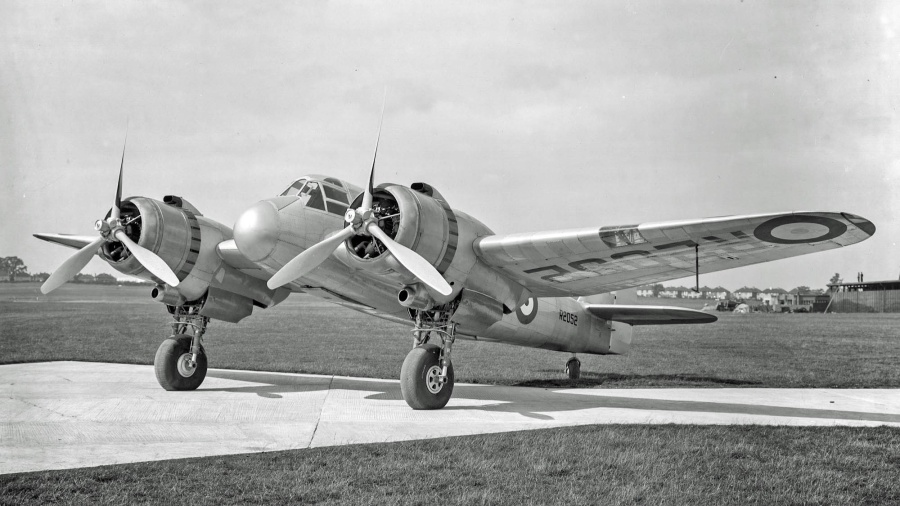
Beaufighter variants included night fighters (Mk.IF variants were fitted with early AI Mk.IV interception radar and first successfully used against Luftwaffe bombers during the Battle of Britain Blitz in 1940), strike fighters and “Torbeau” torpedo fighters. The Beaufighter had a crew of two – pilot and observer/radio operator (radar operator in night fighter variants).
During the war they served in large numbers with the Royal Air Force and Coastal Command (including a Free Polish Air Force night fighter squadron), Royal Navy Fleet Air Arm, Royal Australian Air Force, Royal Canadian Air Force (four squadrons operated in Europe, three in the night fighter role), Royal New Zealand Air Force, South African Air Force and the United States Army Air Force (USAAF 414th, 415th, 416th and 417th Night Fighter Squadrons operated 100 Beaufighter’s in Italy and later France from the Summer of 1943, until the last Squadron re-equipped with Northrop P-61 Black Widow night fighters in March 1945). Turkey also operated a small number from 1944.

Beaufighter’s were generally powered by a pair of Bristol Hercules 14 cylinder radial engines, which provided a top speed of 515 km/h (320 mph). However, due to engine unavailability, 597 early production Mk.IIF night fighter aircraft were fitted with Rolls Royce Merlin XX engines, with exhaust ducting and later shrouds to cover exhaust flames at night. The Merlin engines resulted in a very unfamiliar appearance!

Close to 6,000 Beaufighters were built between 1940 and 1946, with aircraft rolling off production lines in Great Britain and also under licence in Australia at Department of Aircraft Production (DAP) factories. British production included 553 Mk.IF night fighters that would later be replaced by 597 Mk.IIF and 1,078 Mk.VIF variants. The strike and torpedo fighters included 397 Mk.Ic, 693 Mk.VIc, 60 Mk.VI (ITF – Interim Torpedo Fighter), 2,205 TF Mk.X “Torbeau” torpedo fighters fitted with a search radar and 163 TF Mk.XIc (similar to the Mk.X but did not carry a torpedo).
British built Beaufighters were armed with 4 x 20 mm Hispano Mk.II cannons under the nose and 6 x 0.303 Browning machine guns in the wings, along with a rear mounted 0.303 machine gun for the observer. Standard underwing ordnance included 8 air to ground rockets or up to four 500 lb bombs. The “Torbeau” variants could carry a single centreline mounted torpedo.
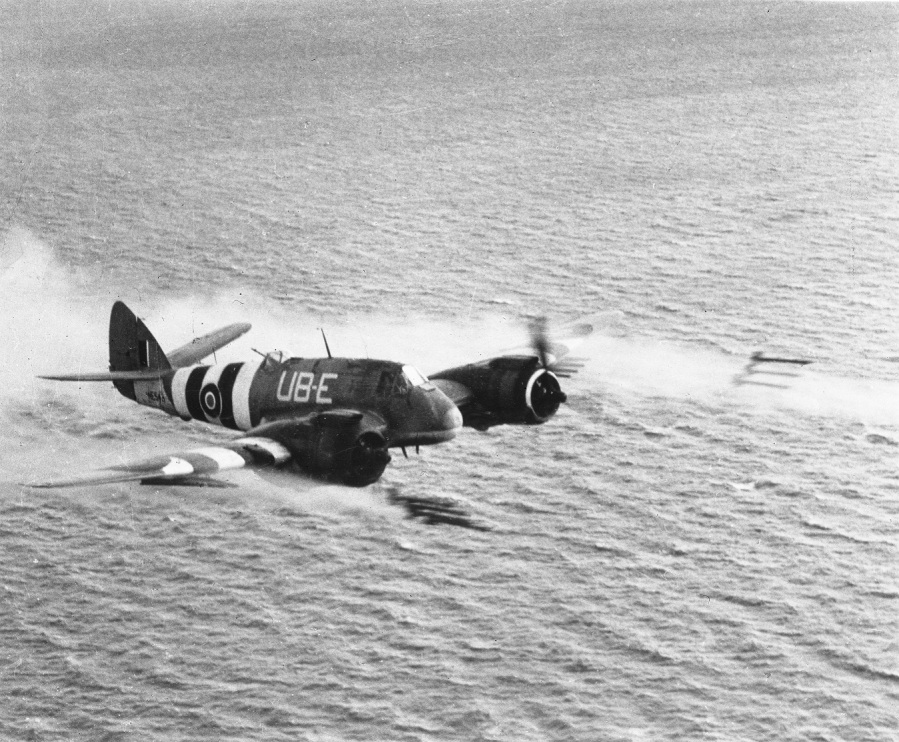

To complement those in service built by the Brits, DAP in Australia produced 365 Mk.21 Beaufighters for the RAAF between 1944 and 1946. Based off the TF Mk.X design, the armament of the Australian built attack and torpedo fighters armament differed with 4 x 0.50 calibre Browning machine guns mounted in the wings. In case of a shortage in war time supply of Hercules engines, Australian tests were also conducted with Wright Cyclone GR-2600 radial engines but these were apparently noisier and didn’t handle as well as the Hercules and were ultimately not required for production aircraft.

The Beaufighter remained in RAF service as TT Mk.10 target tugs until 1960 and in the same role with the RAAF until the mid 1950’s. Otherwise, those not lost in combat and accidents were mostly reduced to parts during the war or scrapped after it.
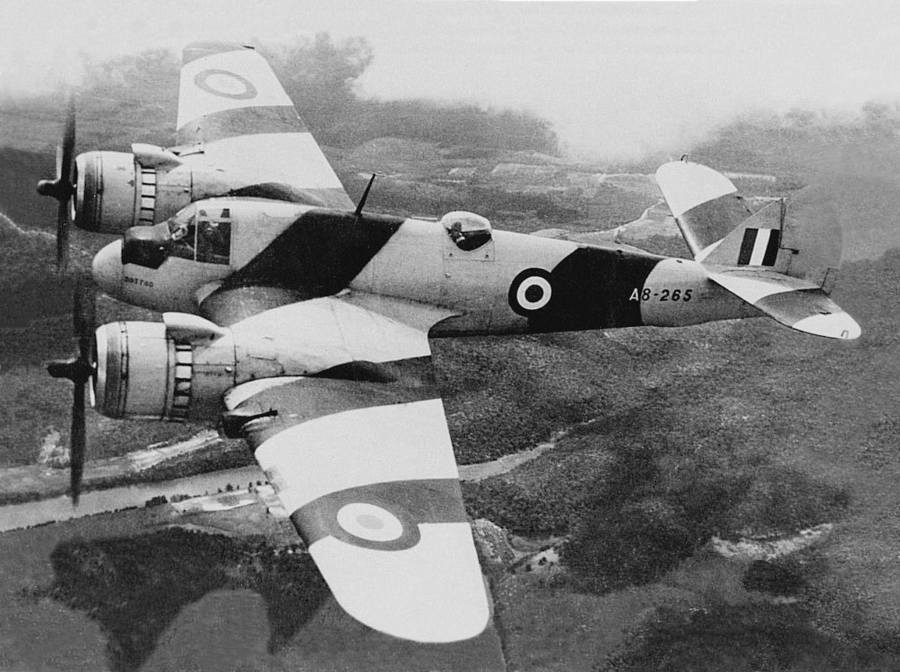
Post war a number of Ex-RAF TF Mk.X torpedo fighters were sold to foreign buyers. Portugal received 16 aircraft in 1945, with a further attrition replacement delivered in 1946 (serviceability issues meant they only served until 1949), Turkey supplemented the 9 TF Mk.X delivered in 1944, with a further 23 aircraft obtained in 1946 and the Dominican Republic purchased 10 in 1948, which remained in service until 1954. Israel clandestinely obtained 4 TF.Mk.X in 1948 but presumably with minimal spares, they remained in service for less than 6 months.
The Survivors
Despite the large numbers produced, just seven complete or near complete Beaufighter aircraft survive today – they are either on display in museums, in storage or under restoration. Another is being restored from an incomplete airframe at the Historical Aircraft Restoration Society (HARS) in Australia.
Two of the survivors are Australian built RAAF DAP Beaufighter Mk.21 aircraft, three are Bristol TF Mk.X torpedo fighters (two former Portuguese Navy examples and a former RAF example), then there are two RAAF Bristol built Mk.Ic strike fighters. Given Australia scrapped so many World War Two aircraft for their precious metal post war, it is fascinating that so many of the survivors served with the RAAF.
AUSTRALIA
Regardless of where they served, currently only two complete Beaufighters can be found in Australia – both are DAP Mk.21 examples (with a third hybrid restoration on the way). The first is the elusive A8-186 within the private collection of the long closed to the public, Camden Museum of Aviation in New South Wales and the other is A8-328 at the Australian National Aviation Museum (Moorabbin Air Museum) in Victoria.
Camden Museum of Aviation
DAP Beaufighter Mk.21 (A8-186) at Cambden was built by the Department of Aircraft Production (DAP) in 1945 and served out the final days of World War Two with RAAF No. 22 Squadron conducting operational flights in the South West Pacific. Post war it went into storage in November 1945, became a RAAF Ground Instructional Airframe in 1947 and was sold off as surplus to a farmer in New South Wales in 1950 – fortunately it was used as a playground for his children and not cut up for spare parts!
A8-186 was acquired by the Camden collection in 1965 and restored using parts from many sources to become “Beau-gunsville“. They also have a nose section for Mk.21 A8-386 dubbed “Harry’s Baby” which never entered RAAF service and the incomplete airframe was later sold as surplus. Unfortunately I have never been to this private museum.

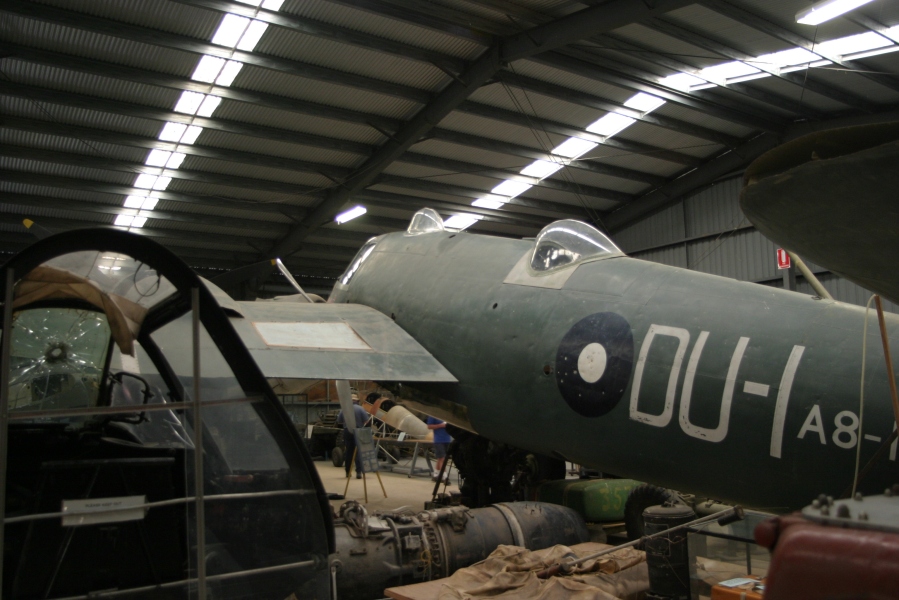
Australian National Aviation Museum
DAP Beaufighter Mk.21 (A8-328) on display in the Australian National Aviation Museum at Moorabbin Airport in Victoria is the most accessible one to view in Australia and takes pride of place within the museum. We are lucky to have this one, delivered in September 1945 and too late to see service during the war, it went into storage until 1950, then it saw out its RAAF career as a target tug until 1956.



Following storage and then disposal in 1956, this Beaufighter ended up at the Lord Mayor of Melbourne’s Children’s Camp in Portsea, Victoria as part of a playground, where it slowly deteriorated away! The airframe was in a bad state by the time the Australian Aircraft Restoration Group acquired it for the Moorabbin collection in 1962 but they restored the aircraft back to its former glory as a tribute to RAAF No. 31 Squadron that operated the type alongside No. 22, 30 and 93 Squadrons in the Southwest Pacific theatre of war. In the past ANAM would even conduct engine runs but this rare bird is not going to fly again!
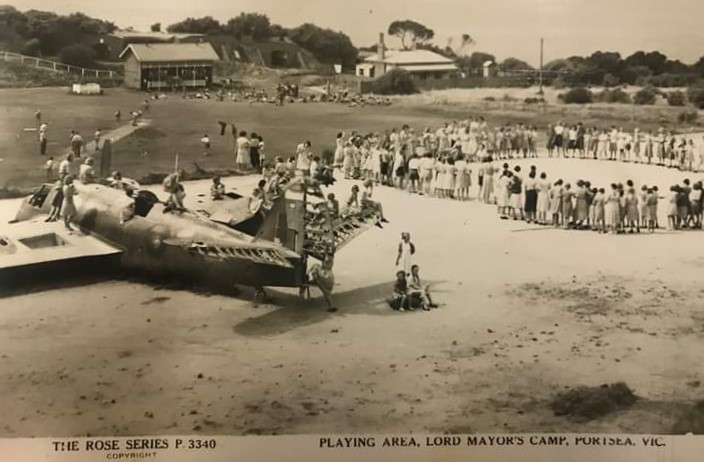
RAAF No. 31 Squadron was formed at RAAF Forest Hill (Wagga Wagga) in August 1942, equipped with Beaufighter’s, they relocated to the Northern Territory in October 1942 and conducted their first operational mission on November 17th, 1942. For the next three years the squadron smashed Imperial Japanese ground targets and shipping in an around the Dutch East Indies, Timor and Borneo.
A famous strike by No. 31 Squadron saw them hit the Japanese held airbase at Penfoei in Timor on December 2nd, 1942. An irresistible target of 40 Japanese aircraft were lined up before them and the RAAF boys destroyed 18 aircraft and heavily damaged the rest, without loss of a Beaufighter! Mission success!
Thanks to the volunteers at ANAM, I was recently extremely fortunate to be able get inside the crew compartment of this heavy fighter and was immediately struck by how tight a space it was inside – imagine getting through the small rear underside fuselage hatch with all your gear and a parachute! I had enough trouble with just a camera – I take it no one moved around in there too much once it took flight! The restoration is a beauty inside and out, and a true treasure.
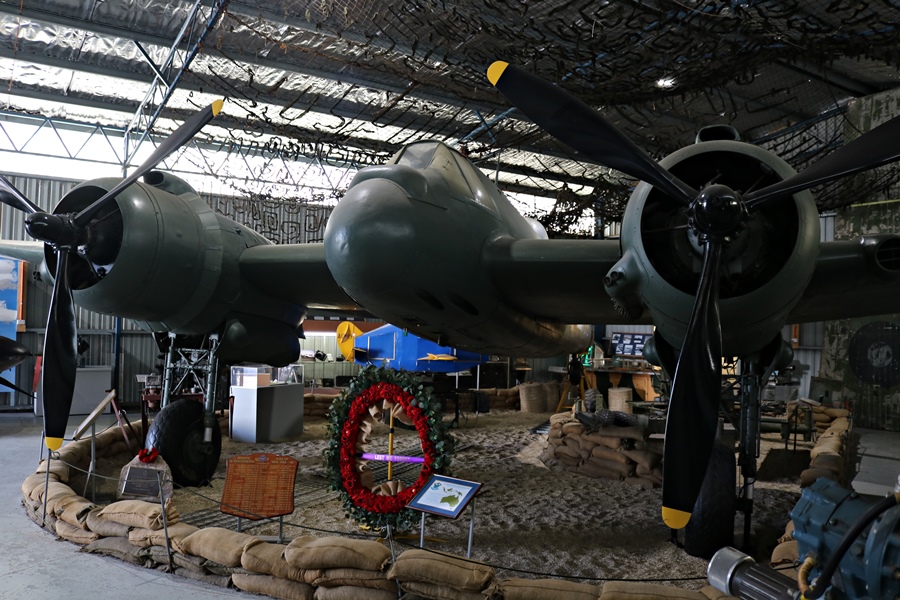

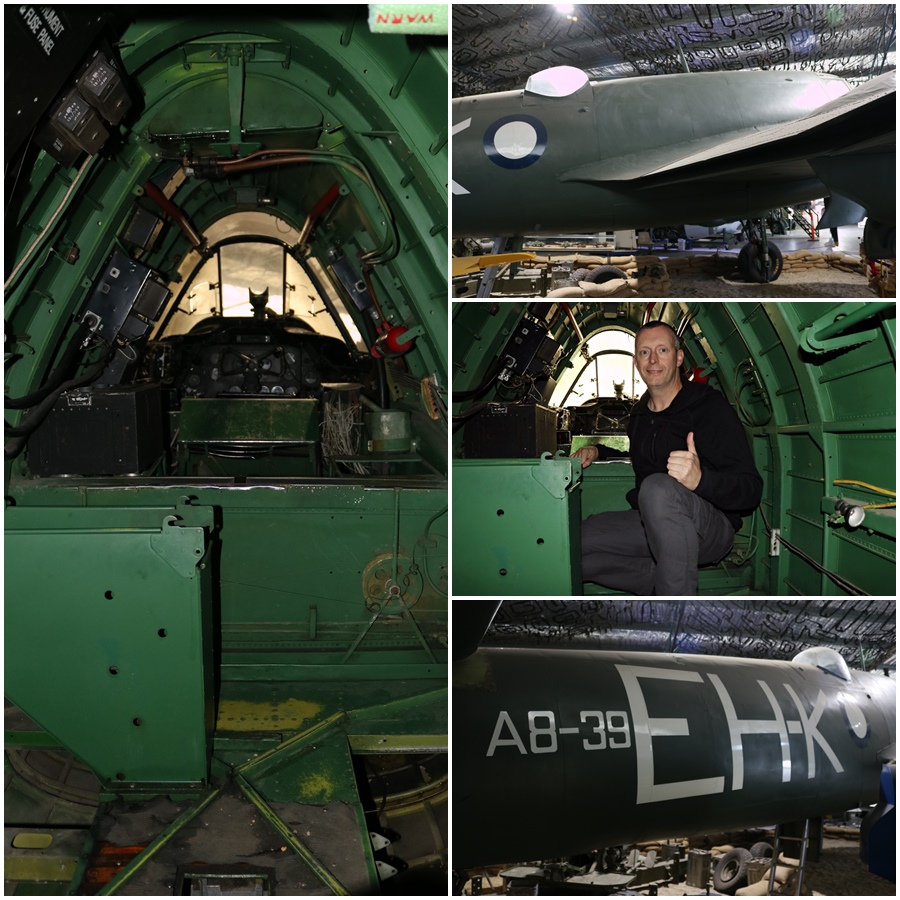



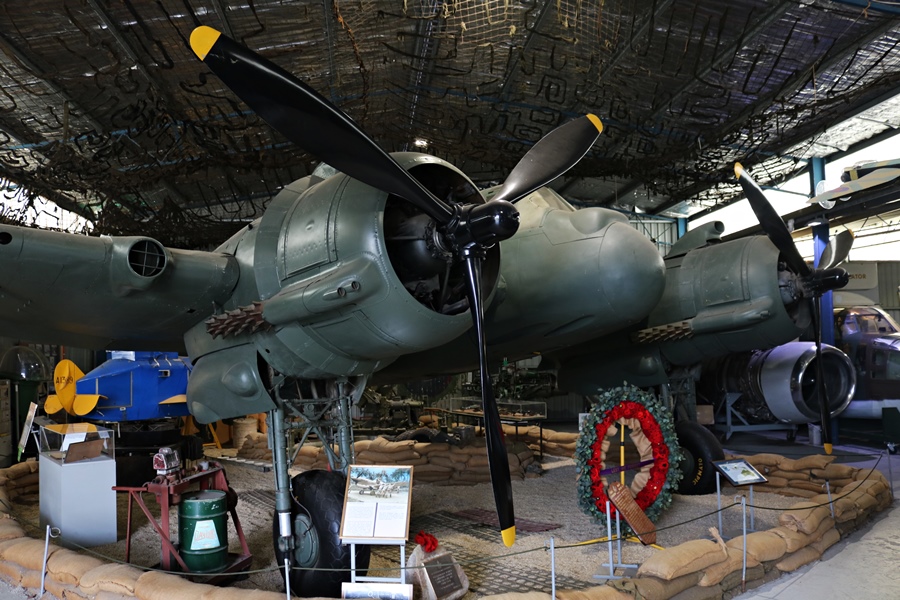

Historical Aircraft Restoration Society
The Historical Aircraft Restoration Society at Albion Park in New South Wales has been collecting Beaufighter parts for many years, including the recovery of the remains of Bristol Beaufighter Mk.XIc A19-144 and A19-148 fuselage centre sections and other parts from northwest Australia in 1981, which found an overseas home for restoration (see The Fighter Collection restoration below). In 1997 a Beaufighter wing centre section, outer wings and numerous parts were recovered from a farm in Dubbo, NSW. They have also completed Beaufighter nose sections for other museums.
HARS have their own DAP Beaufighter Mk.21 restoration project underway using the fuselage from A8-384. This aircraft was not delivered to the RAAF and remained an incomplete airframe at the end of World War Two. Bristol Hercules engines are being restored and they have acquired the nose section of RAF Bristol Beaufighter Mk.IF (X7688) from the UK, along with a large quantity of engine spare parts from New Zealand. The intention is to restore this to be a flyer some day.
CANADA
The Canada Air and Space Museum in Ottawa, Ontario has a 1945 RAF Bristol Beaufighter TF Mk.X (RD867) torpedo fighter under restoration but requires Hercules engines and other parts. Built after the end of World War Two, this aircraft went into storage in 1945 but was operated by the RAF in the UK and Malta as a target tug from the late 1940’s until retired in 1958.
Restored by the RAF for display as a night fighter in 1966, the Beaufighter was swapped with the RAF Museum in 1969 for a RCAF Bristol Bollingbroke (Blenheim) but for whatever reason did not include Bristol Hercules engines, cowlings or internal components in the trade (the engines sit on RD253 at the RAF Museum – see below)! I wish I had been able to see this project when I was at this excellent museum in 2013!
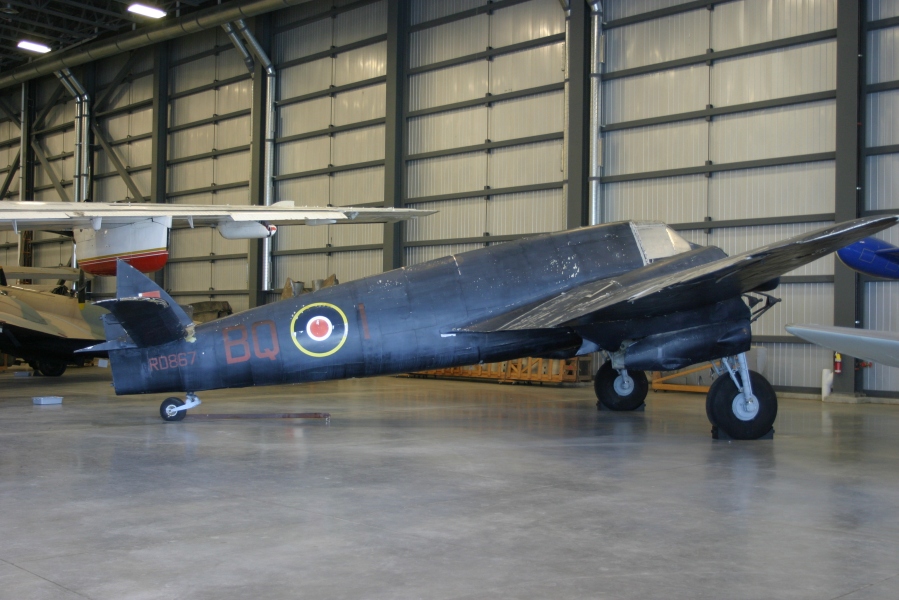
UNITED KINGDOM
RAF Museum Hendon
The RAF Museum in Hendon has on display a Bristol Beaufighter TF Mk.X torpedo fighter (RD253), which was built in October 1944 and destined for the Portuguese Navy Air Arm. It was ferried to Portugal in March 1945 and operated there on maritime patrol duties. Serviceability appears to have been an issue and most were grounded by 1946 and the last Portuguese Beaufighter was officially retired by 1949.


By 1950 RD253 had been acquired as a ground instructional airframe for the Lisbon Technical Institute. In 1965 the aircraft was presented to the RAF for preservation and shipped to the United Kingdom. Restoration began in February 1967 with parts sourced from other components held and recovered by the RAF and was completed in 1968. The aircraft went on display at RAF Museum Hendon in 1971. It is displayed in RAF livery and markings. D-Day stripes were added in 1994.


IWM Duxford
Members of The Fighter Collection are undertaking a long term restoration of an RAAF Bristol Beaufighter Mk.Ic at the Imperial War Museum Duxford in the UK. This is intended to be a flying restoration but has been hampered for many years by a lack of serviceable Bristol Hercules engines, as was the case when I was at the museum in 2012.

This aircraft is depicted as A19-144, a British built Beaufighter that served with RAAF No. 31 Squadron in the South West Pacific from 1943 to 1944 and was credited with shooting down an Imperial Japanese Army Kawasaki Ki-45 Toryu (“Dragonslayer”) heavy fighter (Allied Codename “Nick”), and damaging another over Timor in December 1943. You can see the Japanese Rising Sun flag painted under the cockpit.
The aircraft is actually a composite of RAAF Beaufighter components sourced primarily from HARS in Australia. The restoration comprises the centre fuselage of Mk.XIc A19-144 (following a landing accident in October 1943 in northwest Australia, the aircraft was approved for conversion to parts in December 1944), the wing centre section of Mk.XIc A19-148 (RAAF No. 31 Squadron 1943-1944, shot down a Mitsubishi Ki-21 Sally in 1943, damaged in a forced landing in northwest Australia in January 1944 and converted to components), the tail section of Mk.Ic A19-36 (delivered 1942, crashed 1944) and the cockpit section of DAP Beaufighter Mk.21 A8-324 (delivered 1945, put into storage 1946, became surplus in 1949).
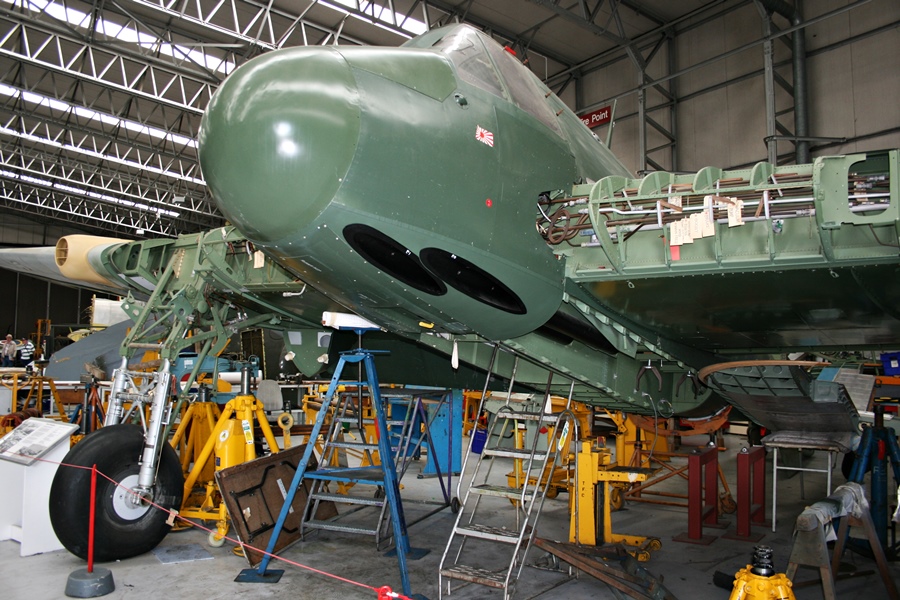

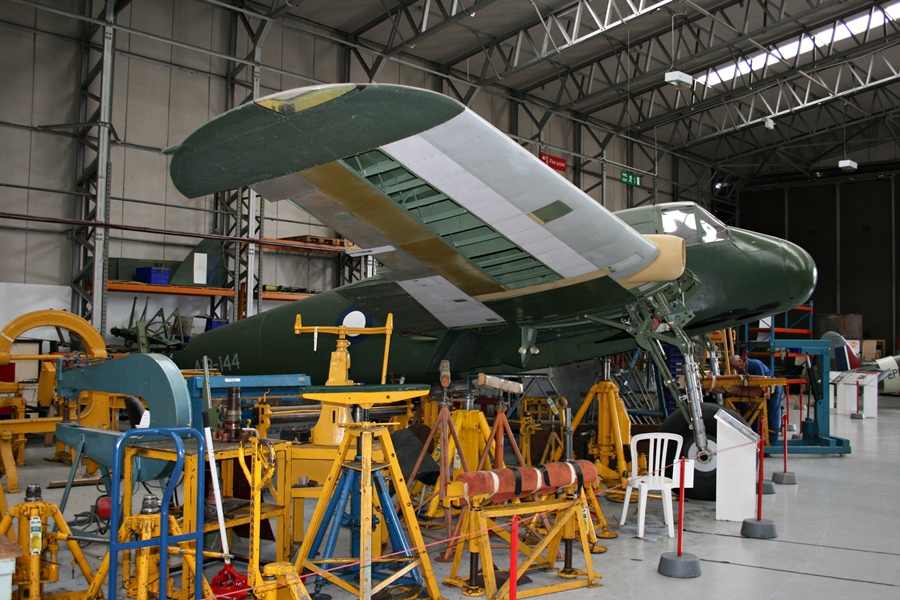
National Museum of Flight
Bristol Beaufighter TF Mk.X (RD220) is under restoration at the National Museum of Flight in Scotland. I haven’t seen this one in person but it is one of the former Portuguese Navy examples and was acquired in 2000 by National Museums Scotland.
By the 1950’s this aircraft was also used as a ground instructional airframe for the Lisbon Technical Institute. From 1966 to 1983 it was in the Portuguese Air Force Museu do Ar collection and later at the South African Air Force Museum. It was in a bad way but relatively intact and will be a long term restoration project.
UNITED STATES
In a somewhat unusual location and guise, RAAF Bristol Beaufighter Mk.Ic (A19-43) today resides within the National Museum of the US Air Force in Dayton, Ohio (acquired in 1988). It was restored between 2000 and 2006 to represent USAAF Beaufighter T5049 “Night Mare“ of the 415th Night Fighter Squadron as flown by Commanding Officer Captain Harold Augspurger, who in September 1944, shot down a Luftwaffe Heinkel He 111 transport carrying German staff officers over France.

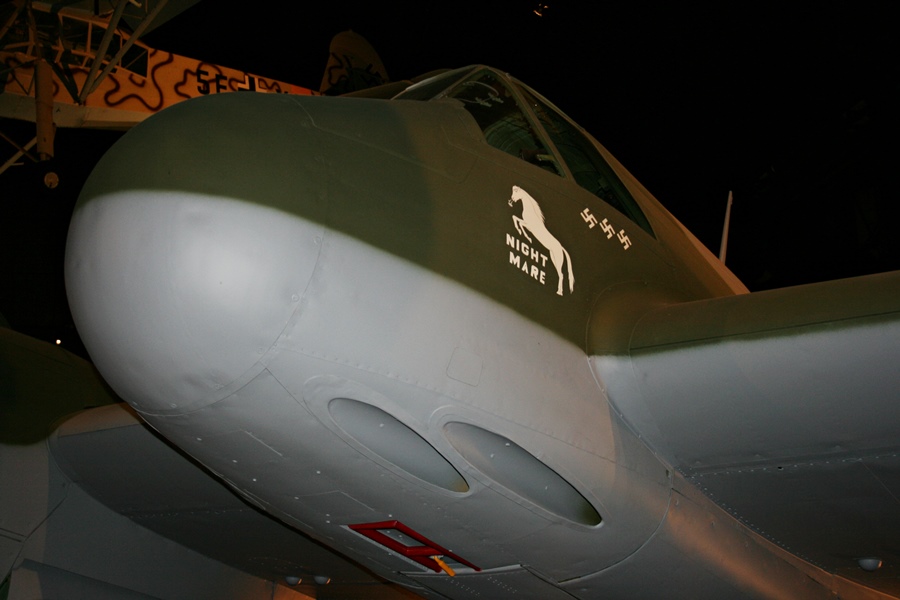


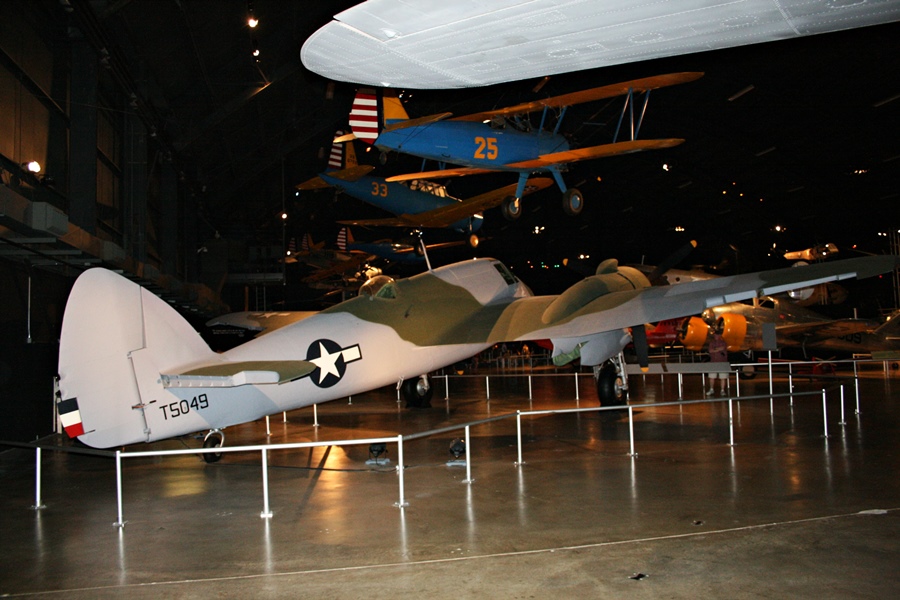
This aircraft was built in Great Britain in 1942 and shipped to Australia that same year. During World War Two it mainly served with RAAF No. 5 Operational Training Unit (5OTU) and No. 31 Squadron. Following landing damage in August 1944 this aircraft was repaired and sent to No. 3 Air Armament Gunnery School at RAAF Nhill in Victoria as a ground instructional airframe. Sold off as surplus to a local famer in 1947, the remains of the fuselage sat on that same property near Nhill until recovered by the Australian Aircraft Restoration Group for the Moorabbin Air Museum in 1971.
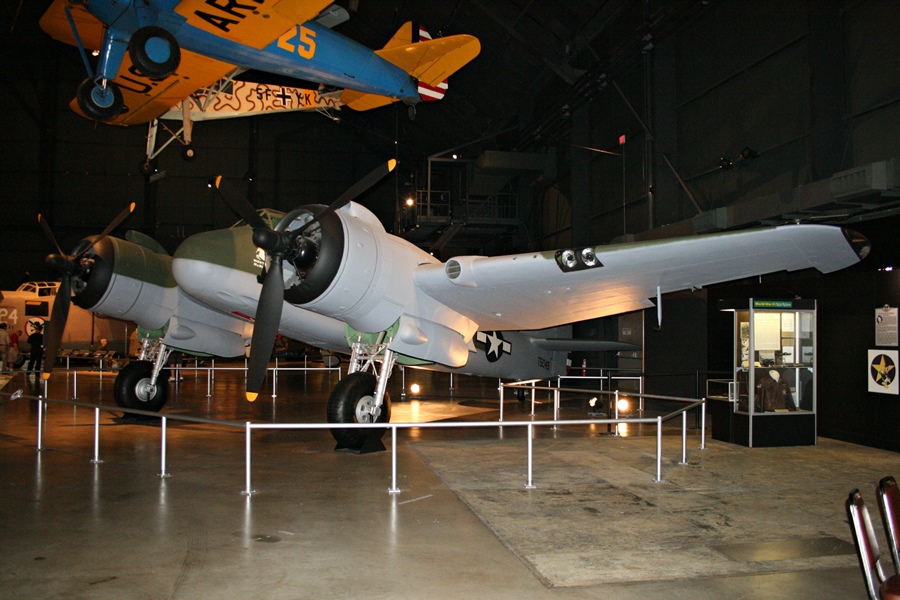

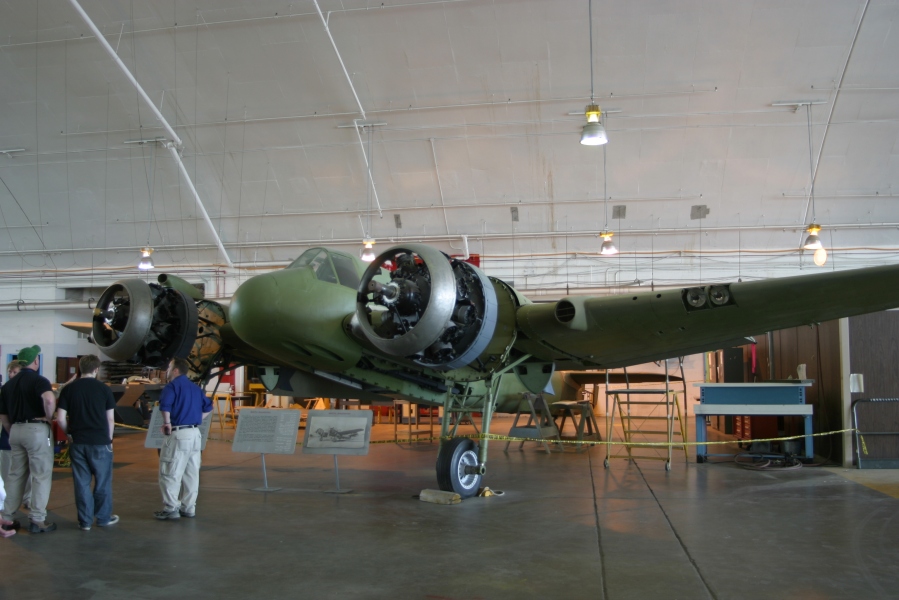
This blog article was originally posted on Aces Flying High – The Survivors on July 7th, 2019.
References:
Australian National Aviation Museum – Beaufighter A8-328
Australian War Memorial – No. 31 Squadron
BAE Systems – Bristol 156 Beaufighter
Canada Aviation and Space Museum – Bristol Beaufighter T.F.X
Friends of the Canadian War Museum – Beaufighter Fact Sheet
Geoff Goodall – Kimberley War Relics
National Museum of the USAF – Bristol Beaufighter
Pacific Wrecks – Bristol Beaufighter Mk.Ic Serial Number A19-43
RAF Museum – Bristol Beaufighter TFX
Virtual War Memorial Australia – No. 455 Squadron (RAAF)

An excellent account of a great aircraft! Well done and thanks for sharing.
LikeLiked by 2 people
Thank you!
LikeLike
Thanks again for an interesting and informative article on the Beaufighter.
My Dad was in the RAAF from 1931 to 1936 but (somewhat to his disgust) was an aircraft inspector with AID during the war. I remember him telling me stories about the Beauforts built by DAP and the Beaufighters being called “Whispering Death”. I think he may have been an inspector at the Mascot assembly plant where they were assembled. He was also stationed at Bankstown and had a great interest in the Bell Airacobras stationed there with the USAAF, and loaned to Australia (?) for a short time in 1942(?)
Thanks for the great articles.
Colin Smeal
LikeLiked by 1 person
Thanks Colin, he would have seen an amazing array of aircraft on his time! Yes the Airacobra’s were on loan as an emergency fighter from the USAAF
LikeLike
Great article and photos!
LikeLiked by 1 person
Thanks Rick!
LikeLike
Dean, I have some photos from Camden and the Canadian Aviation Museum if you would like to use them.
LikeLiked by 1 person
Thanks. Sounds good Dean. I will send you an email
LikeLike
It’s a great aircraft and quite adaptable too. It’s nice to see a few survivors about.
LikeLiked by 1 person
Agreed!
LikeLiked by 1 person
If only one was flying!
LikeLiked by 1 person
I read C F Rawnsley’s ” Night Fighter while
paralleling his experience as guy-in-back,
421st TFS during Easter Offensive, 1972.
The squadron had a history of night fighters
from P61 days. It also operated largely at night from Da Nang.
LikeLiked by 1 person
Great story! Now, if you could only infiltrate Camden…
LikeLiked by 1 person
Thanks. That would be something!
LikeLiked by 1 person
Has anyone spotted the error in the presentation of the Camden Museum Beaufighter ? Its been there a long time.
LikeLike
Be nice to see it someday
LikeLike
Thank you for such an in depth article on one of my favorite aircraft, I only hope that I will be able to see one fly again
before I join the Heavenly quire invisible. Thank you
LikeLiked by 1 person
Thanks. That would be something to see for sure!
LikeLike
I understand HARS was responsible for the majority of the restoration work on the one in the USAF Museum at WPAFB
LikeLiked by 1 person
It travelled far and wide that airframe!
LikeLike
Photo of the Beaufighter at East Fortune (taken in 2014) can be seen here; https://www.flickr.com/photos/88888327@N03/15226202560/in/album-72157647841718379/
LikeLiked by 1 person
Thanks Martin. Good to see
LikeLike
My father flew Beaufighters during World War 2 in both the Night-Fighter and Ground Strike variants. sadly he is no longer with us but his memory remains. He spoke very highly of the aircraft praising it in so many different areas including its amazing performance a very low level as well as its ‘Beau Kiss’. Because of the glare from the cannon and machine guns he would close his eye s the moment the guns fired.
Do you have any idea when one of the restoration projects will take to the skies again.
Regards
Peter Willans
LikeLiked by 1 person
Hi Peter, He would have had some death defying stories no doubt? The HARS example will be the most likely as I believe the Duxford one is lacking suitable engines. Regards Dean
LikeLike
Hi Dean, He rarely spoke of his flying in Beaus though he did mention in some detail a scrap with an ME110 over London at night. Another comment from him was that they were amazing aircraft at ultra-low level better, he says, than the Spitfire or the Mosquito. I met his former squadron leader in 1980 in Nottingham. He showed me some private photographs, taken by his observer, of the squadron in flight. They were tooled up for action. He remembered Dad (sort of) who would very likely have been in one of the aircraft pictured. A chilling thought but I was so proud.
I have seen the Beau at Camden Museum and was so moved I started crying. They look so big and powerful. I hope I can see one flying in my lifetime.
LikeLiked by 1 person
Important family history. I hope we all do. Will be something to see!
LikeLike
I spent many years being involved with the restoration of A8-328, it was my introduction into aircraft restoration, from paint stripping the interior as a young member to assisting with re building the running Hercules, and may other jobs on the airframe and systems and still involved at the museum over 50 years on.
LikeLiked by 1 person
Great to hear you continue to be involved.
LikeLike
I look forward to the day when one takes to the air again. A tribute to the men , like my dad, who flew them and those who died in them.
LikeLiked by 1 person
That will be something to see for sure!
LikeLike